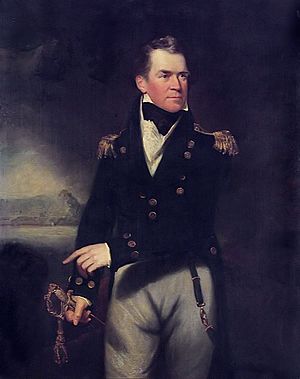HMS Newcastle (1813) facts for kids

Newcastle
|
|
Quick facts for kids History |
|
|---|---|
| Name | HMS Newcastle |
| Ordered | 6 May 1813 |
| Builder | Wigram, Wells & Green, Blackwall |
| Laid down | June 1813 |
| Launched | 10 November 1813 |
| Completed | By 23 March 1814 |
| Fate | Broken up in June 1850 |
| General characteristics | |
| Class and type | 50-gun fourth rate |
| Tons burthen | 1,556 bm |
| Length |
|
| Beam | 44 ft 8 in (13.6 m) |
| Depth of hold | 15 ft 1+1⁄2 in (4.6 m) |
| Sail plan | Full-rigged ship |
| Crew | 450 |
| Armament |
|
HMS Newcastle was a powerful warship of the Royal Navy. She had 50 guns and was built during a time of big conflicts, like the Napoleonic Wars and the War of 1812.
Newcastle was a special kind of ship called a "spar-decked frigate." She was designed to be strong and fast, especially to compete with large American frigates. She worked with other ships to try and catch these American vessels, but the war ended before they could. Later, Newcastle became a flagship, which means she carried a high-ranking officer. After her active service, she was used as a lazaretto, a ship for keeping people in quarantine. She was eventually taken apart in 1850.
Contents
Building a Warship: HMS Newcastle
HMS Newcastle was ordered on May 6, 1813. She was built by a company called Wigram, Wells & Green in Blackwall Yard. To get her ready quickly, she was made from pitch pine, a type of softwood.
She was laid down (meaning her keel, the backbone of the ship, was put in place) in June 1813. Amazingly, she was launched into the water just five months later, on November 10, 1813! She was then moved to Woolwich Dockyard to be finished by March 23, 1814.
Why Newcastle Was Built
Before this time, ships with 50 guns, called "fourth rates," were not very popular. But the War of 1812 changed things. American ships like USS Constitution were very strong and had a special design with a "spar deck." This made them tough opponents. So, the British Navy decided to build new 50-gun ships like Newcastle and her sister ship, HMS Leander, to match this new threat.
Ship Design and Armament
Newcastle was a "spar-deck frigate." This meant she had two main decks for guns.
- On her main deck, she carried thirty 24-pounder guns.
- On her spar deck, she had twenty-four 42-pounder carronades. Carronades were shorter, powerful cannons used for close-range fighting.
- She also had four 24-pounder guns on her forecastle (the front part of the upper deck).
After the wars ended in 1815, Newcastle and Leander were changed to have special living areas for important naval officers. This allowed them to serve as flagships in different parts of the world. In 1817, both ships were officially re-rated as 60-gun ships.
HMS Newcastle at Sea
Newcastle began her active service in November 1813. Her first commander was Captain George Collier. However, he soon moved to command Leander, and Captain Lord George Stuart took over Newcastle.
In May 1814, Newcastle accidentally collided with a ship called Diligence. All 40 passengers on Diligence were saved, but one crew member drowned. Diligence was towed back to port, and Newcastle had to go for repairs.
Newcastle also worked with other British ships, Leander and Acasta, to capture enemy ships. For example, on December 28, 1814, they captured a famous American privateer (a privately owned warship) called Prince de Neufchatel. This ship was armed with 18 guns and had a crew of 129 men. A few days later, on January 4, 1815, the same group of British ships recaptured a ship named John.
Chasing the USS Constitution
One of the most exciting parts of Newcastle's career involved chasing the famous American frigate Constitution. Captain Collier, who was now on Leander, was watching Constitution in Boston harbor. When he had to leave to get supplies, he left Acasta and Newcastle to keep watch.
While Collier was away, Constitution and two other large American frigates left Boston. When Collier returned, he prepared to chase them. The British squadron finally spotted Constitution and two captured British sloops, Levant and Cyane, on March 11, 1815. The weather was bad, and there was some confusion, which allowed Constitution to get away.
However, fire from Newcastle caused the crew of Levant to run their ship ashore. Acasta then captured Levant. Captain Collier continued to search for Constitution, but she had already returned to port, avoiding another fight.
End of Service
Newcastle was taken out of active service in January 1822 at Portsmouth. Between April and June 1824, she was refitted to become a lazaretto. This meant she would be used to hold people or goods in quarantine to prevent the spread of disease.
In September 1827, she moved to Liverpool. Newcastle spent the rest of her career in this role. The Navy finally sold her on June 12, 1850, and she was then taken apart.


